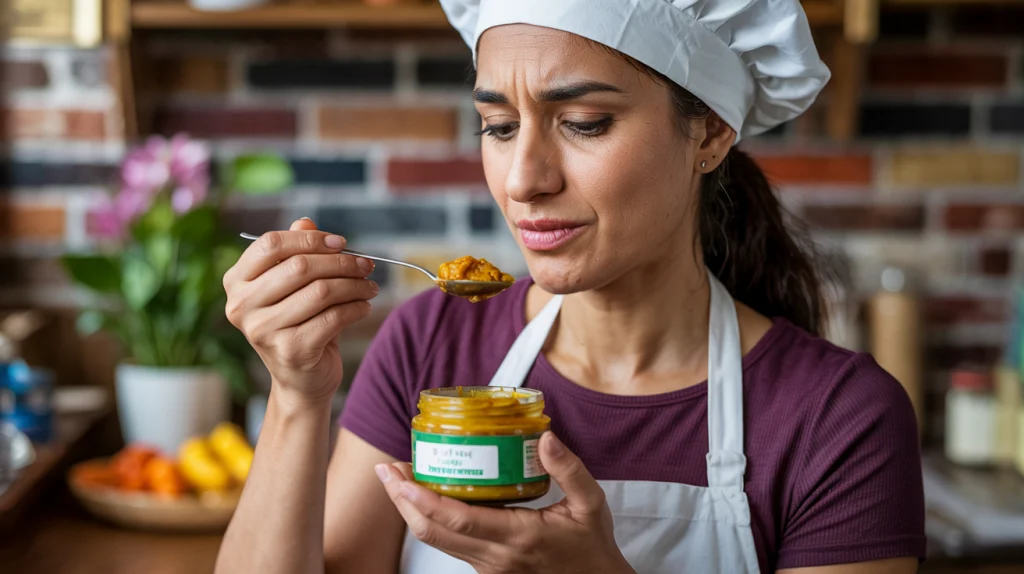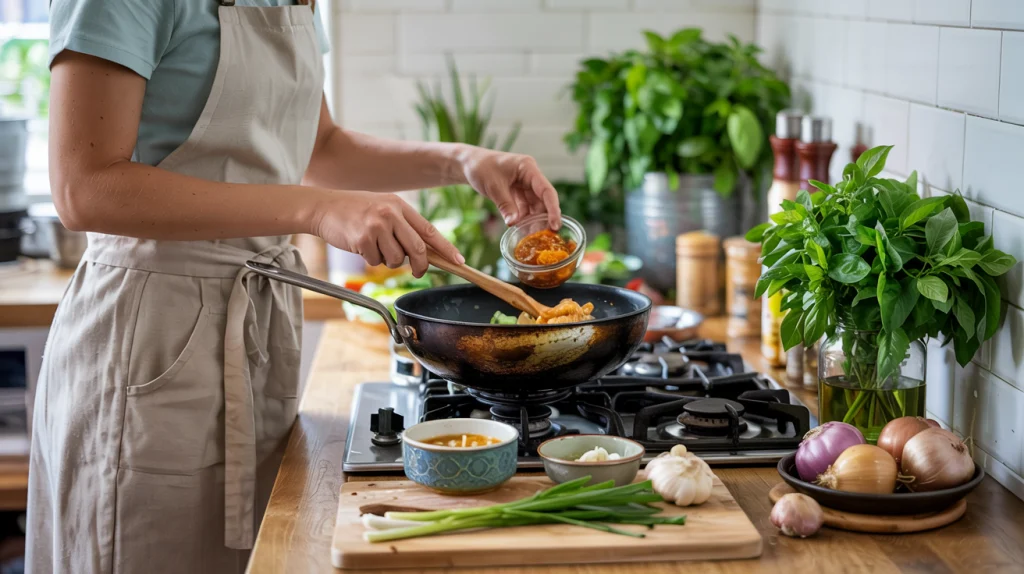That jar of curry paste hiding in the back of your refrigerator might be causing you some worry. If you’re like me, you’ve probably found yourself staring at an opened container, trying to remember when you last used it. Can old curry paste make you sick?
Food poisoning is a real concern with any aged food product. The best way to tell if curry paste has gone bad is to look for changes in color, texture, or smell. If mold is present or there is an off odor, it should be discarded.
While the high salt content in curry paste helps preserve it, other components like fresh herbs can degrade and potentially harbor harmful bacteria.
Curry paste is a popular choice for home cooks wanting to create authentic Indian dishes or Thai cuisine without minimal effort. These flavor-packed pastes combine essential ingredients like coriander seeds, lemon juice, and various spices.
Most commercial curry pastes have a surprisingly long shelf life when stored properly. An unopened container kept in a dry place can last for months or even years. But once opened, the clock starts ticking.
For best results and to avoid foodborne illness, always check expiry dates and store opened paste in an airtight container in the refrigerator. Some clever cooks even freeze small amounts in ice cube trays for longer preservation!
Below, we’ll get into how to know if curry paste has expired. But we’ll also look at whether it’s still safe to use beyond the expiration date. But we’ll also look at both Indian curry as well as Thai.
Either way, many people make curry with coconut milk.
But since it’s cheaper, can you buy refrigerated coconut milk in place of canned?
Click here to read my article which breaks down the exact differences between canned and carton coconut milk. While both are obviously coconut-based, there’s one key difference that could radically alter the flavor of your curry.
But there’s also a work-around if you want to go the carton route.
Is food terrible after the expiration date?
To answer this question, we need to understand a few things about the dates printed on food packages. There are, in fact, two main types of dates used to describe the condition of foods on their packaging: “best before” and “use by.”
Let’s start with “use by.” These are the dates you need to pay the closest attention to. If you have something with a “use by” date printed on the packaging, this refers to food safety; it means that you need to use the food by the date printed on the package.
These foods are usually prone to bacterial growth over time, and they need to be kept in the refrigerator to slow the growth.
- Milk
- Eggs
- Yogurt
- Meat
- Cheese
- Diced fruit and vegetables
On the other hand, “best before” dates refer to the quality of the food that’s labeled. Food that has gone beyond its “best before” date isn’t dangerous; they may just not taste quite the same.
Packaged dry foods often use “best before” dates. These foods tend to lose flavor or change in texture – like going stale – over time.
- Canned foods (vegetables, beans, soups)
- Dried pasta
- Cereal
- Chips and crackers
- Cookies
- Soft drinks
Now, we all know that these dates aren’t always reliable; we’ve all cheated a little and eaten things after their expiration dates. If you have handled your food well, it is likely to last for a time beyond its expiration date. (source)
To determine if something has truly gone wrong, you will need to look for other signs of spoilage before consuming to make sure you don’t get sick. Here are a few examples.
- Sour smelling milk
- Changes in color in meat and poultry
- Mold or yeast growth
- Unusual variations in flavor and texture
If anything seems questionable, it may be best not to take the chance and throw it out.
How long does curry paste keep?
The first thing you need to consider when asking if your curry paste (and really any food for that matter) is still good is whether or not it has already been opened.
Store-bought curry paste has a surprisingly long shelf life compared to many other pantry items. Unopened jars or tubes can last 2-3 years when kept in a cool, dry place away from direct sunlight.
The shelf life dramatically changes once you break the seal. Most commercial curry pastes contain preservatives like salt and oil that help extend freshness, but proper storage becomes essential at this point.
For best results, always check the expiry dates printed on the packaging. These are your first line of defense against spoilage.
The best way to store opened curry paste is in an airtight container in the refrigerator. Some home cooks transfer leftover paste to ice cube trays, freeze them, and then pop the cubes into a plastic bag for easy portioning.
Thai Curry Paste
Thai curry pastes typically last 2-4 weeks in the refrigerator after opening. These pastes often contain fresh ingredients like lemongrass, kaffir limes, and thai basil that deteriorate faster than dried spices.
The high oil content in Thai curry pastes helps preserve them, but they’re still vulnerable to oxidation. Adding a thin layer of olive oil on top before sealing can extend freshness by creating a protective barrier against air.
Red and green Thai curry pastes tend to last longer than yellow or massaman varieties due to their higher chili content, which acts as a natural preservative.
Indian Curry Paste
Indian curry pastes generally keep for 4-6 weeks in the refrigerator after opening. These pastes often use more dried spices like coriander seeds and black pepper, which naturally have a longer shelf life than fresh ingredients.
Commercial Indian curry pastes sold at your local grocery store typically contain food-grade preservatives that extend their usability without compromising safety.
If your Indian curry paste develops a darker color over time, it’s usually not a sign of spoilage but rather oxidation. However, any mold growth or off smells indicate it’s time to discard it to avoid potential foodborne illness.
If you are going the Indian curry route, you might also have some Indian pickle on hand.
Does pickle go bad? And if so, how can you tell? Click here to read a detailed article I wrote that shows you exactly what to check for with Indian pickle to make sure it’s not bad. After all, most of us buy a jar and stick it in the fridge for a year or two. But there’s 1 crucial thing to check before you use it!
What makes curry paste go bad?
High humidity can compromise the quality, even if it is still sealed. Heat and moisture conditions create the perfect environment for bacteria to grow.
On the other hand, once the curry paste has been opened, the expiration date changes. This doesn’t necessarily mean it will go bad quickly (if it is stored correctly); it simply means that the quality will start to go down quicker.
Once a jar of curry paste has been opened, even when it is stored in the refrigerator, you can expect that it will remain at its best flavor for the next two weeks. Its flavor will start to decline, and you can expect it to taste stale and less flavorful four weeks after opening.
The kind of container it is stored in can also make a difference.
Curry paste maintains its quality best over time in a glass jar. Plastic containers can often leach plastic into the paste, or they may absorb some of the color and flavor of the curry paste itself.
How are Thai and Indian curry pastes different?
When you are referring to curry paste, it is usually always Thai curry, not Indian. There are some very distinct differences between the two, as described in a recent article.
Most notably, that article gets into why most curry pastes and powders don’t actually use the leaves of the curry plant. Just click that link to read it on my site.
Besides the type of spices used in each, Indian curry usually starts with a blend of powdered spices, including most, if not all, of the following:
- Coriander
- Cumin
- Turmeric
- Cayenne chili powder
- Fenugreek
- Cardamom
- Cinnamon
- Garam masala
Thai curry, on the other hand, begins with a paste. There are several types of Thai curry, but the base ingredients usually include:
- Ginger
- Garlic
- Lemongrass
- Galangal (Thai ginger)
- Chili peppers
Because Thai curry is more “liquid” based, it will eventually go bad once it is opened. The question is, when?
As we mentioned previously, Thai curry paste – once it is opened – tastes best within two weeks, but it will keep for at least a few months. Its flavor will still be decent, and the quality will remain much the same.
If my curry paste is expired, should I add more to increase flavor?
There’s an important distinction between curry paste that’s simply old versus curry paste that has actually spoiled.
Let’s be clear about this difference.
Curry paste that shows visible signs of spoilage – mold, off smells, unusual texture, or strange coloration – should be discarded immediately. There’s no amount of cooking at high heat that can make this safe, and it could lead to serious foodborne illness.
However, curry paste that’s expired but has been stored properly in an airtight container and shows no signs of spoilage has likely just lost some of its flavor potency. In this case, adding a bit more to your stir fry or hearty soup is perfectly reasonable.
The essential ingredients in Thai curry paste, like coriander seeds and Thai basil, gradually lose their aromatic compounds over time. This is especially true for pastes containing fresh herbs and spices rather than dried ones.
For best results with older (but not spoiled) paste, try using 1.5 to 2 times the amount your recipe calls for. You might also want to enhance it with complementary fresh ingredients like green onions, lemon juice, or a little oil with black pepper heated together.
Next time, consider storing small amounts of curry paste in ice cube trays and freezing them to maintain flavor longer. This approach works well for both Indian dishes and other Asian cuisine favorites.
So, basically, yes, if you add more expired curry paste, it will likely increase the flavor.
It may not be the flavor you are expecting. It will just taste like a more robust version of the expired paste rather than what the curry should taste like if it were fresh.
Final thoughts
Staying safe with curry paste comes down to proper storage and awareness. When in doubt, it’s always better to discard old curry paste rather than risk food poisoning that could severely impact your immune system.
For next time, consider freezing excess paste in ice cube trays. This method works well for both homemade and store-bought varieties from Asian markets or your local grocery store.
In recent years, home cooks have embraced curry pastes from various cultures – from Indian cuisine to Japanese cuisine. Each type of curry paste has its own set of flavor profiles and ideal storage conditions.
Remember that even while refrigerated in an airtight container, opened curry paste typically remains at its best quality for only a couple of months. After this, it may not make you sick immediately, but the vibrant flavors that make your favorite dishes so special will have diminished significantly.
Most people know both India and Thailand have curry.
But what about Vietnam? And if so, how does Vietnamese food differ from Thai? Click here to read my ultimate guide comparing both Vietnamese and Thai food. I get into all the ways they are similar. But I also cover the 1 key difference that forever makes them very different.
- Easy Egg and Hashbrown Breakfast Casserole Recipe - September 29, 2025
- Easy Buffalo Chicken Dip Recipe (for Your Best Game Day) - September 29, 2025
- Brown Butter Brookies Recipe (Fudgy and Chewy) - September 29, 2025







Question: A1 Instant Curry Paste in vacuum sealed foil- unopened kept in pantry which states … best before…28/02/2020… that’s almost a year ago. Can it still be used ? Thank you.
Hi Christina
If the packaging is 100% intact with no signs of having been opened, it should be fine. I would probably open the package, see how it looks and smells, and assuming all that seems fine, would likely use it, but store it in the fridge moving forward.
Of course, if you see any signs of molding or off-smelling odors, toss it. And of, course, if it’s inexpensive, it’s always safer to throw it out and not take a chance. But most likely, it’s fine.